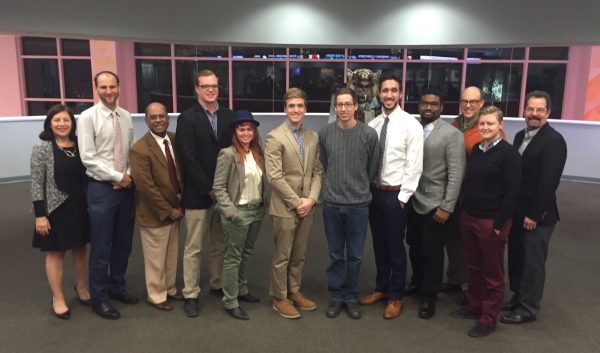Representatives of Temple University’s Innovation and Entrepreneurship Institute meet with winners of the 2016 Innovative Idea Competition.
Through entrepreneurship, Temple University students, faculty, staff, and alumni united at the 19th annual Innovative Idea Competition.
The competition engages entrepreneurship at Temple, and invites those affiliated with the university to share their innovative ideas for products, services, concepts, and technologies that could lead to new businesses. Ideas in all stages of development were eligible for submission.
The Innovation and Entrepreneurship Institute (IEI) at the Fox School of Business hosted the Nov. 10 event, which was held at Alter Hall. IEI received 426 submissions from 14 of Temple’s 17 schools and colleges, marking a 21-percent increase in submissions from last year’s competition. The competition welcomed submissions from local community colleges, as part of a program funded by Temple’s Center for International Business Education and Research (CIBER).
“The Idea Competition is unique in that it allows participants to take an idea out of the theoretical and see its potential for becoming a reality,” said Ellen Weber, IEI Executive Director. “All of our participants have access to mentors during the application process who can help them develop their ideas and begin that mode of thinking.”
Ideas were put to the test as finalists competed for spots in eight cash prize categories.
Nigel Satenstein, a Business and Management major at the Fox School, won the overall grand prize of $2,500, as well as the first place in the People’s Choice Award category and the Global Innovative Prize. He walked away as the competition’s winner, with prize money totaling $4,000.
His idea – Pinpointer – would connect the more than four billion people worldwide without a home address to global e-commerce markets through the use of precise digital codes. In countries like China, India, and Nepal, the lack of sufficient home addressing infrastructure makes it impossible for online order deliveries to be shipped to someone’s door, Satenstein said. The customer, rather, has to arrange for pick-up of their orders at nearby landmarks, such as a school or a church.
Pinpointer would deliver a “virtal breadcrumb” technology, Satenstein said, that tracks the customer’s journey from his or her home to the pick-up location. This way, the next time the consumer orders a product online, the delivery service can follow the trail of a previous delivery in order to reach the customer’s front door.
“This was an amazing opportunity from Temple to help jump-start our business, and we hope this momentum will carry through for the rest of our current funding round,” Satenstein said. “Pinpointer will use the money we won to expand our efforts at tech development, hire additional workers and bolster our servers used to store collected data. The rest of the funds will be used for marketing and customer-acquisition efforts.”
Lewis Katz School of Medicine student, Conor Vickers, took home first place for the Graduate, Faculty, Staff, or Alumni category. He won $1,000 for SensiFoam, a concept for a product that would prevent pressure ulcers or bedsores with a disposable foam patch that can wirelessly transmit pressure data to a tablet device. Fox School student Peter Agada clinched second place in the same category and earned a $500 prize, for his wearable balance device. His idea involves eyeglasses that have sensors measuring the head, leg, and trunk movements, and changes in elevation that ultimately would help to prevent falls for the elderly.
In the Undergraduate category, both first and second place went to students from the College of Engineering. Christopher Ricci received the $1,000 first prize with his idea of a regenerative suspension system. Designed for automobiles, it would use kinetic energy from road disturbances to create electrical energy. The $500 second prize went to Emily Knight for Prohibere, which would use a hair and skin serum to eliminate the urge for people with trichotillomania to extract their hair.
Audience members got into the action, too. For the third consecutive year, attendees cast votes for the People’s Choice category using their smartphones.
“The pitch event provides an opportunity for the finalists to use the questions and feedback from our judging panel to identify the next steps toward testing their ideas and building them into something real,” Weber said.

